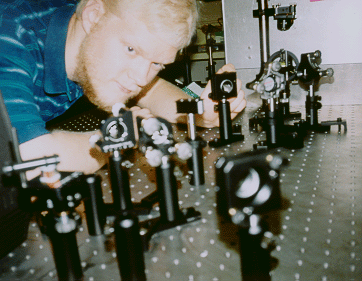The ability to manipulate micro- and nano-scale structures is clearly at the forefront of current scientific concerns -- and is also an area which is currently seeing very rapid progress. At Illinois Wesleyan, we are interested in optical momentum, optical forces, and optical torques and -- generically -- in micro- and nano-scale transport and assembly processes, as well as medium-mediated interactions.
Techniques using lasers to trap and manipulate matter have already aided our understanding of (nano-scale) molecular motors and unraveling DNA, and have also had great impact on studies of (micro-scale) cellular-level physics and hydrodynamic interactions. Yet, while
basic optical traps have been used for many of these studies, a
wider range of techniques holds promise for revolutionizing the degree of control possible for
localizing,
guiding,
spinning, and even
optically organizing matter on length scales that are of enormous technological importance. However, it will take significant effort to develop these technologies to their full potential. Along the way, a great deal of physics emerges.
Our work aims to significantly extend the capabilities of laser trapping, making it possible to sculpt light into modes and patterns that provide important new functionality. For example, we can now
controllably adjust the orientation of trapped matter - a core capability for the sort of "lock and key" assembly required by some biological (and micro-machine) systems.
We also aim to utilize novel light modes and patterns to create and optimize optical "
bottles" for cold atoms, laser
guiding of matter, reconfigurable optical "
sieves" for separation of bio-molecules, along with one-, two-, and three-dimensional optical "
lattices" which allow for a variety of basic studies. To do all of this, we pass laser beams through computer-generated holograms (of our own design), thereby forming a tailored potential energy landscape which causes micro- or nanoparticles to assemble themselves into a desired structure. Thus, in the end, we produce
holograms that are not merely ethereal images; they have corporeal substance.
Our work also aims to enhance the extent of nanoparticle localization (
i.e., reducing trap volumes) and of control over large-scale organization of micro- and nanocomponents. On the nano-scale, we envision a variety of single-molecule studies, as well as highly selective size- and shape-dependent optical sorting of chemical nanoprobes. On the microscale, interest in organizing components into larger structures or assemblies stems from many quarters, including the desire to organize biological cells during organ and tissue growth, the desire to create photonic-bandgap materials and devices, and the desire to create
model thermodynamic systems for the study and elucidation of collective phenomena/many-body effects in tailored potential landscapes and even of biological assembly processes. It should also be noted that the microfluidic technologies that currently hold so much promise for lab-on-a-chip technologies require novel approaches to mixing and sorting, and the reconfigurability of optical micromanipulation has much to offer.

